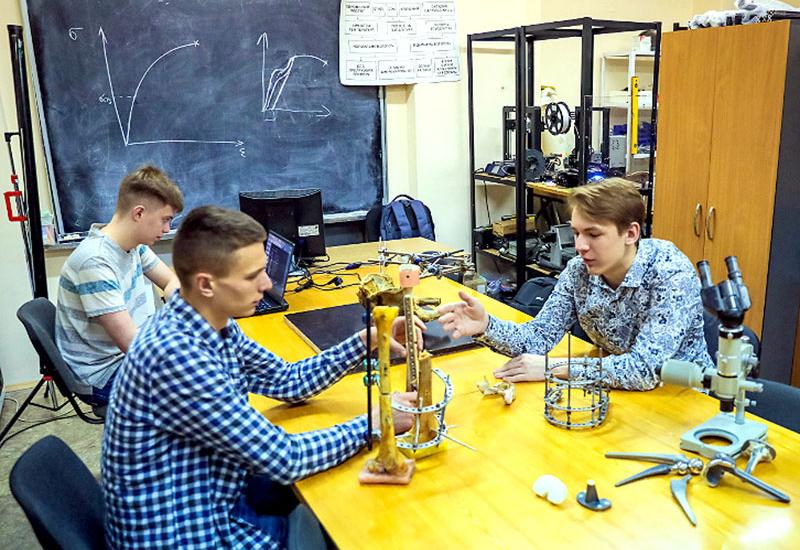The scientific student group “Experimental Research of New Materials and Biomechanical Systems”, which operates at the Department of Dynamics and Strength of Machines and Resistance of Materials of the Educational and Research Mechanical Engineering Institute, is an example of the important work of young scientists and students in creating prostheses for wounded soldiers and anyone who needs surgery to restore mobility.
🗟
The group has existed for more than 15 years and is justifiably proud of its history and achievements. Associate Professor Mykola Shydlovsky was at the origins of the youth group. He was one of the first to use composite materials in biomechanical systems. That is, to study, based on the ideas and methods of mechanics, the peculiarities of the motor actions of the human musculoskeletal system, in particular the behavior of bone tissue in different states. At the request of medical institutions, the scientist developed and researched osteosynthesis systems of increased efficiency for the surgical treatment of complex human bone fractures, means of diagnosing the strength and reliability of biomechanical systems “bone-joint-implant” taking into account damage to biological tissues, etc.
In co-authorship with students, scientific corrections were published, and titles of protection for utility models were obtained: for determining the hardness and elastic modulus of bone tissue, measuring the displacement of human bone fragments at fracture sites, etc. Today, students and followers of the innovator continue to work on this topic. Today, one of the activities of the group is modernization of fracture fixation devices and improvement of joint implantation. You will agree that the topic is extremely relevant and important, because during Russia's full-scale invasion of Ukraine, the number of military and civilians who have been injured and need quality treatment and rehabilitation has increased significantly. Olha Musienko, a senior lecturer at the Department of Dynamics and Strength of Machines and Resistance of Materials, is in charge of the young innovators.
It is known that prostheses and osteosynthesis devices are used for complete or partial loss of limbs. There are no manufacturers in Ukraine that produce revision knee prostheses. Doctors order them from abroad, and the cost of such products reaches thousands of euros. Therefore, employees of medical institutions that cooperate with Igor Sikorsky Kyiv Polytechnic Institute scientists asked for help, and the students set out to create a domestic revision knee prosthesis from scratch.
It should be noted that the results of the research of schoolchildren, students and graduate students who participate in the club are comprehensively discussed, reported on at national and international scientific conferences; the club members participate in competitions, including the Sikorsky Challenge Festival of Innovative Projects, master classes, hackathons, workshops, and receive recognition and support. For example, one of the group's members, fourth-year student Oleksii Morgun, was awarded the NAS of Ukraine Prize this year (it was established for young scientists and students of higher education institutions who have written the best scientific papers). He once admitted that when he entered Kyiv Polytechnic, he dreamed of working for the world-famous Boeing Company. But he never thought that he would become one of the developers of a prosthesis to restore mobility. “Such developments are important to me because of their benefit to people, and it's also a cool experience,” says the student.
It is worth noting that the team of the club actively uses a variety of approaches and methods for their research. These are not only practical developments (for example, stands for researching biomechanical systems), but also theoretical developments. “The group's activities are carried out at several levels aimed at achieving specific goals,” says Olha Musienko, ”We create mathematical models using Solidworks, Autodesk Inventor, and SpaceClaim CAD programs, and we also use modern package systems such as ANSYS. In addition, the results of studies of the mechanical properties of bone and muscle tissue are used to create these mathematical models to describe the behavior of materials. In other words, experimental studies in the development of such complex and expensive structures as implants are closely linked to theoretical calculations. This is a prerequisite for systems engineering, which includes the validation of mathematical models.”
Young MMI researchers collaborate with leading trauma surgeons from various medical institutions in Ukraine. Among them are the Bogomolets National Medical University, the Ukrainian Military Medical Academy, and the Institute of Traumatology and Orthopedics of the National Academy of Medical Sciences of Ukraine.
The importance of the club's work is especially noticeable in times of war. “The number of requests from doctors for research on biomechanical systems has increased significantly since 2014,” the department notes. The team of the club is enthusiastic about such work, because they believe that it is a significant help in the rehabilitation of wounded soldiers and civilians and is their contribution to bringing the Victory closer.

